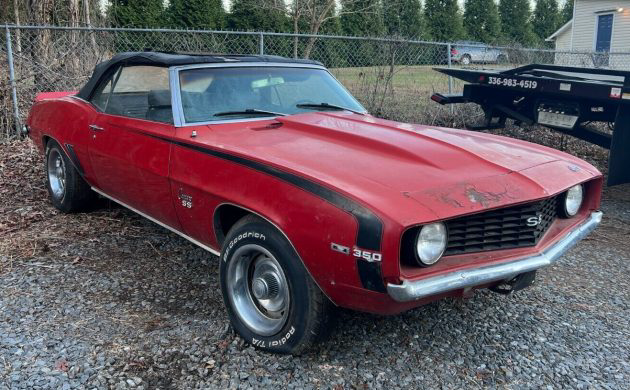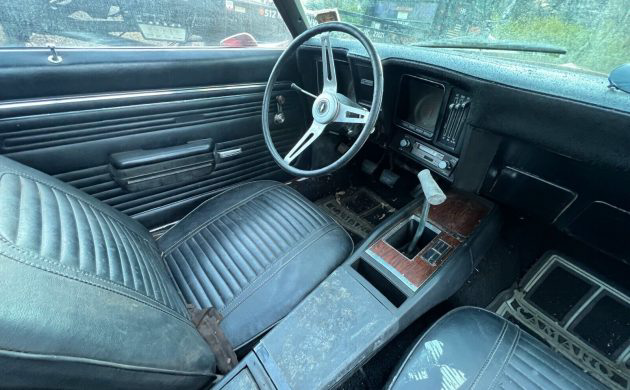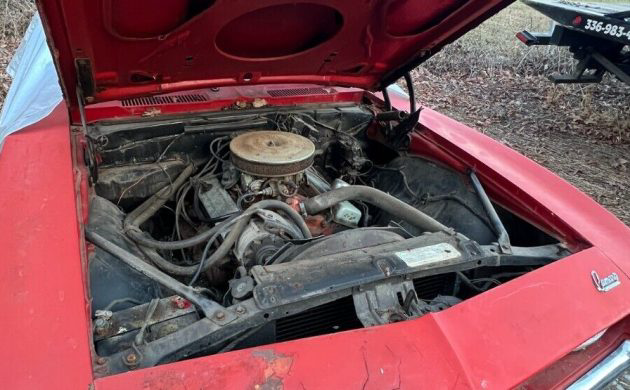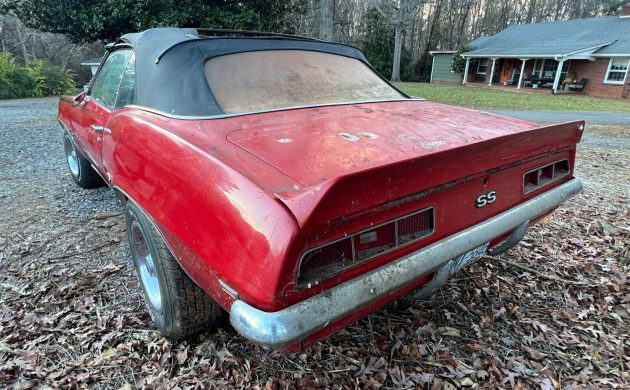As a writer, I have always found the 1960s to be the most challenging time when compiling articles for our faithful Barn Finds readers. That is not because it was a decade littered with bad cars. The opposite is true. It witnessed an increase in stunning Personal Luxury Cars, the emergence of some of the greatest muscle cars in automotive history, and the arrival of the pony car. This genre significantly changed the automotive landscape. This 1969 Camaro Convertible falls into the third category and is a recent find needing its share of love. It is essentially complete, leaving the winning bidder with a range of project paths from which to choose. The first step will be for the Camaro to find a new home, with the seller listing it here on eBay in King, North Carolina. Bidding has scorched beyond the reserve to sit at $19,790.
While my automotive tastes could be considered eclectic, I am passionate about first-generation pony cars. They possess styling purity largely lost as dimensions and weights increased during the 1970s. They also offered buyers scope to spec them with drivetrains that would give almost any muscle car a run for its money. The history of this Camaro Convertible is unclear, but I’m positive the SS badges are a later addition. They may have been applied when the car underwent a color change because the Cowl Tag confirms the original owner ordered it in dazzling Daytona Yellow. The winning bidder faces a long list of tasks to recapture its former glory, but the auction action suggests that plenty of people are willing to roll up their sleeves and give it a red-hot go. The panels are generally straight, but there is visible rust in the usual lower body extremities. I see plenty of cutting and welding in this classic’s future, although it appears structurally sound and nowhere near being considered a lost cause. The soft-top is shredded, but with its frame appearing restorable, addressing this issue should cost under $500. The glass shows no significant problems, and the Rally wheels add a sense of purpose.
This Camaro’s interior is complete, and apart from the aftermarket radio/cassette player, it is unmolested. It is another area begging for love, but the first step in that process will undoubtedly be to perform a deep clean. The images suggest there may be many salvageable items, which may reduce the cost of this build. The Black vinyl upholstery is rip-free, while the dash and pad look pretty respectable. A close inspection will undoubtedly reveal a few problems, but it appears the new owner won’t face the cost or inconvenience of a complete retrim.
The original owner ordered this Camaro powered by a 350ci V8, but whether the car retains its original powerplant is unclear. It produced 250hp and 345 ft/lbs of torque, and when coupled to a four-speed manual transmission, it allowed the Convertible to cover the ¼-mile in 15.9 seconds. The small-block should run out of breath at 124mph, and while the performance is not in SS territory, it would have satisfied most owners. The seller confirms this classic has lain idle since 1992, and the information they supply is minimal. It is unclear whether the car is numbers-matching, when the Chevy last fired a shot in anger, and whether the engine turns freely. They appear approachable, so compiling a list of questions to ask before submitting a bid might be a wise first move.
This 1969 Camaro Convertible is not a genuine SS, but transforming it into a worthy tribute is one option available to its new owner. A faithful restoration is another, as is the restomod approach. It requires many hours of work before it graces our roads again, but the thirty-six bids submitted confirm some enthusiasts believe they are up to the challenge. If you harbor the same feelings, are you tempted to submit the thirty-seventh? I wish you luck if you do.







Adam, good write-up but one question. How can you be sure that this was not an original SS? In 1969 the SS base engine was the 350 and not the 396
Easy enough to glance underneath. 10 bolt and single leaf spring means it isn’t. Engine looks stock so doubt anyone spent the time and money to change them out. Even in the 80’s a 12 bolt Camaro unit was pricy.
The VIN number and data plate on the firewall are a good starting point. Finding the “build sheet”, a.k.a. the “broadcast sheet” would be the best source of information, if it’s still with the car. Looking at parts isn’t the best method, simply because parts may have been replaced after fifty-four (54) years! My baby brother’s ’69 Firebird needed new bearings in the rear end, but instead rebuilding the rear end, we swapped out the rear end for one from a wrecked Camaro, and replaced the leaf springs and rear shocks with new ones while were at it. In hindsight, that was a mistake, but as they say, you live and learn!
The VIN decodes as originally a 6 cylinder engine built in Norwood, Ohio.
Emission control sticker indicates the original motor was/is a 350 with a 2-barrel carb.
What can I tell you? The ad lists a VIN of 123679N517675. The 3 in the 3rd digit is for 6 cylinder. An 8 would be a 4. The 67 indicates convertible. The 9 is for 69 and N is for Norwood. I believe that the 12 is for Camaro.
Eric, you are correct, the vin indicates an L6 motor. I think this car probably has a newer front clip, a closer look at the emissions sticker, down at the very bottom, informs that this car conforms to a regulation put into effect in 1972!
No, not a new front clip, my mistake, a 72 is a much different look, emission sticker plate probably came off the car that the 350 came from.
Daytona Yellow at birth. I think it would be beautiful if restored back to that color. I love it. GLWTS.
A basically solid example in need of some love. I’m not a fan of the shift knob it’s wearing right now, but that’s easy fix. Of greater concern is the rust, because there’s the rust you can see, followed by the rust that you can’t see! Only a complete paint stripping will tell you how bad the rust is, and once you’ve stripped off all of the paint you’re on track for a full restoration no matter what removing the paint reveals! Hopefully the only rust is what’s visible, and there’s not too much Bondo lurking under the paint, LOL!
I think the seller maid out like a bandit to get $20,000 for this tired old rust bucket.
Your reply made me curious about the value of the dollar as $20,000 doesn’t buy what it used to. Over the years I’ve talked about the blue with white stripes ’69 Z28 that was parked in the street with a sale sign asking $3,500! That car had a couple of event points for me the first being just walking past it almost everyday from the time it was brought home new! That was the era of spoilers and brake vents, just the overall look of going100mph standing still! I was really thrilled when I learned that the car belonged to my english teacher! And one day walking past the car there was a sale sign in the driver’s door glass asking $3,500 obo! I googled the value of $3,500 in 1972 vs the value of today’s mass produced fiat monopoly game $…the answer is $25,274.68 in 2023. 1972 was when Nixon’s real crime was committed! That’s when he took America’s $ off the gold standard which freed the corrupt politicians to spend with no regard to having dollar-for-dollar gold reserves backing the paper!
In 1972 I bought a 57 Chevy convertible for $150 out of a salvage yard that was in better shape than this this car, in that it only needed floorboards, drivetrain, interior, and top replaced. The exterior sheet metal only needed light body work and repaint. Just from what I can see in his add, this car has rusted to the point every body panel needs to be replaced, to restore it correctly. I doubt the frame is even savable. It’s at $21,000. right now, the poor chum who buys it is headed for big disappointments.
You can bet the rust you can’t see is substantial. Many replacement panels, interior,wiring, mechanicals with paint and body work would well exceed what you could purchase a nice example for.
The single leaf spring is typical of a six cylinder 69 camaro.
Be nice restored to its original Daytona yellow with the 6cyl engine – betcha a dollar when they swapped in the 2bolt main 350 they never changed the gear box.
Lots of funny stuff going on with this. Emissions tag says applicable to 1972 model year on the lower section of it .
Very crusty, needs everything, at $20K, buyer better be a shop that can ALL the work. Being a shop we would not buy in at that price, needs to much to get it correct for resale to an increasingly discerning market.
In ’69 mono leaf for 10 bolts and base V-8, 12 bolts, 350, SS and Z-28, BB, Got 4 leaf usually.
It only needs one thing and that’s EVERYTHING
Been there , done that
Fenders, doors, hood, full 1/4 , most probably floors , buy a complete and ready one after a full inspection , enjoy and pay monthly ! Again , been there, done that
Had to wait 10 years to drive mine , would have been better to drive and pay for 10 years , cause you can’t get those years back !
There comes a point where the body rot is so bad, that it would be cheaper to pick up the phone, call Dynacorn, and drop a brand-new body onto a freshly rebuilt drivetrain. By the time you cut out all of the rotten metal and weld in new panels, not much of the original body will be left in any case, so you’re not missing very much IMHO. Has this car reached that point of no return? I don’t know, maybe, maybe not, but without stripping the body down to bare metal, everyone, including me, is just guessing. My guess is that you might be able to save it, but I could be wrong. It wouldn’t be the first time, and it probably won’t be the last, LOL!
It’s back, relisted on Ebay, bids to $5,200